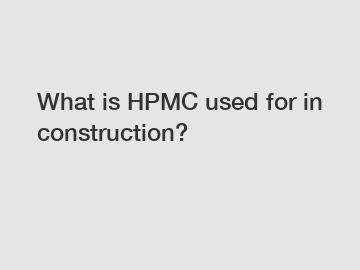What is HPMC used for in construction?
What is HPMC used for in construction?
Hydroxypropyl Methyl Cellulose (HPMC) is a commonly used additive in construction materials due to its multifunctional properties. This cellulose derivative plays a crucial role in improving the performance of various construction materials, such as cement, mortar, and plaster. .
The primary purpose of using HPMC in construction is to enhance the workability and consistency of the materials. By adding HPMC, the flow properties of the mixtures can be improved, allowing easier handling and application. The high water retention capacity of HPMC ensures that the cementitious materials maintain adequate moisture during the curing process, resulting in optimized hydration and increased strength development.

HPMC is also an effective thickener, which helps to prevent sagging or dripping of the applied materials. This is particularly important in vertical applications, such as plastering or tile fixing, where the materials need to adhere to the surface without sliding down. With the addition of HPMC, the viscosity of the mixtures can be increased, providing better sag resistance and maximizing the bond strength.
Furthermore, HPMC acts as a film-forming agent, contributing to the formation of a stable and protective film on the surfaces of construction materials. This film enhances the durability and weather resistance of the materials, preventing water penetration and reducing the potential for cracking or deterioration.
In terms of the underlying science, the multifunctional properties of HPMC can be attributed to its unique chemical structure. HPMC is derived from cellulose, a natural polymer found in plant cell walls. Through chemical modifications, such as hydroxypropylation and methyl substitution, the properties of cellulose are improved, making HPMC soluble in water and imparting it with specific functionalities.
The significance of using HPMC in construction lies in its ability to optimize material performance and improve overall construction quality. With the enhanced workability and consistency provided by HPMC, construction professionals can achieve a more efficient and effective construction process. The improved bond strength, durability, and weather resistance of the materials contribute to the longevity and sustainability of the constructed structures, reducing the need for frequent repairs or replacements.
In conclusion, HPMC is widely used in construction for its multifunctional properties. Its ability to enhance workability, consistency, sag resistance, and durability of construction materials makes it an indispensable additive. Through its unique chemical structure, HPMC provides various benefits that contribute to the optimization of material performance and construction quality. As a result, HPMC plays a crucial role in modern construction practices, ensuring the long-term success of construction projects.
For more information, please visit HPMC supplier, Ideal suspension effect HPMC, hydroxypropyl starch ether manufacturer.

Comments